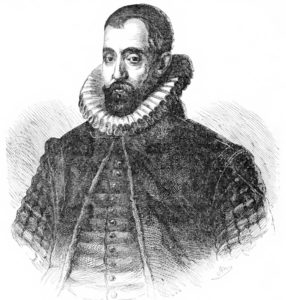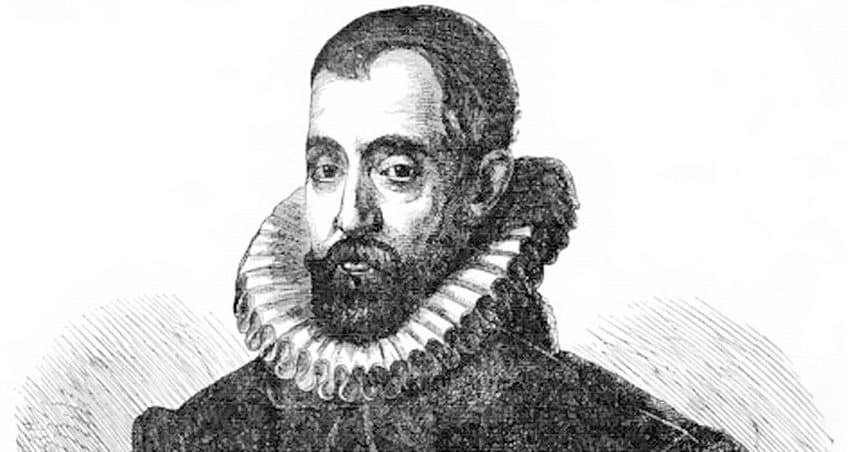
Francis Walsingham was Elizabeth I’s Principal Secretary; his loss was a significant one for her. The cause of his death was said to be testicular cancer; he may also have had kidney stones and diabetes (the 58-year-old Walsingham had complained of ill health and pains for a good twenty years).
Walsingham was…controversial, to say the least. His main legacy was not his work as Secretary, but his activities as Spymaster – and the fact that he discovered the plot that brought down Mary, Queen of Scots. Protestants loved him, Catholics hated him. No one paid attention to the reality that more likely lay somewhere in the middle.
Walsingham was part of a Protestant intelligentsia that included Philip Sidney, Edmund Spenser, and John Dee – men who promoted an expansionist and nationalist English Renaissance. He was lauded as a major patron of virtue, learning and chivalry. He also fervently defended Elizabeth I’s Protestant reign against any claims by the Catholic Mary Queen of Scots or her supporters. Because he was in France in 1572 and witnessed the atrocities of the Bartholomew’s Day Massacre of the Huguenots (French Calvinist Protestants), he saw his work as commanded by God. After all, the assassinations were believed to have been instigated at the highest levels (by Queen Catherine de’ Medici herself), and were followed by a wave of mob violence directed against anyone who questioned Catholic teachings – as he and his friends did. Walsingham (and many others) were convinced that a similar slaughter would occur in England if Mary Queen of Scots ever came to the English throne, and so he fought against that possibility with everything he had.
Now, the Crown had always had a spy network that was able to intercept letters from the French and Spanish ambassadors (often in code!), but Walsingham took things much further. He employed a web of informers and intercepted a lot more than official correspondence. His staff included Thomas Phelieppes, a cryptographer who was an expert in deciphering letters and in forgery, and Arthur Gregory, who was skilled at breaking and repairing seals without detection. This led him to discover several Catholic plots against Elizabeth, all aimed at replacing her with MQS. The problem was, Elizabeth was never convinced of Mary’s complicity so Walsingham set about to prove it…In doing so, he didn’t quite cross the legal line to entrapment, but he did order Mary’s custodian (I was going to say jailer but that sounded so harsh) to leave open a path for clandestine correspondence so that it was all a matter of waiting for conspirators to discover it. Sure enough, Sir Anthony Babington took the bait and wrote to Mary about his group’s plans. Walsingham’s further patience paid off when Mary replied – actually sanctioning in writing the assassination of Elizabeth.
Or did she? Mary denied this vehemently, and accused Walsingham of making it all up. It wasn’t that far fetched that he would have done so – these types of forgeries were common enough that when the then-Princess Elizabeth wrote her famous Tide Letter (great letter, btw – you can read it here) after she was accused of participating in Wyatt’s Rebellion, she drew harsh lines across the space she left empty to make sure no one would add a false confession. Paraxoxically, I think that makes it more likely that Walsingham was telling the truth: he knew he had to overcome Elizabeth’s natural cynicism. If he really wanted Elizabeth to agree to execute MQS, the crime had to be real. And when you add in the fact that rash action was completely in character for Mary, I do believe Walsingham. Do you?
SOURCES: As always, Wikipedia is the first stop for the basic facts.
***
If you like my posts, you’ll love my books! The Path to Somerset came out on August 24 – have you ordered your copy yet? Click on the photo to be taken to Amazon.Com:
(What? You haven’t read Jane the Quene yet? Here are some easy links to Amazon.Com, Amazon.Co.UK and Amazon.Com.Au!)


I have no doubt whatsoever that Mary Queen Scots intended to assassinate Elizabeth I. Mary never doubted she was England’s true monarch and Elizabeth just bastard usurper.
I have never been convinced that MQS intended or sanctioned the assassination of Elizabeth I. I think Walsingham’s hatred of anything Catholic was responsible for the events that led to Mary’s downfall and I wouldn’t put forgery on his and other’s parts as responsible. Looking at her replies to Babbington, I’m not sure she ever directly said “I’m okay with Elizabeth’s death.” her words were riddles and could be taken several ways- Walsingham of course convinced the Queen that Mary was guilty. I think she was grasping at the straws wanting after 19 years to be free. She was not raised in the art of statecraft as was Elizabeth- she was naive and men constantly betrayed and used her. Her tragedy was trusting that her cousin would welcome her with open arms. I hope if there’s another world that Walsingham is burning in Hell. No one in England was Mary’s equal as far as having the right to try her She wasn’t a subject but held against her will. I suppose the truth will never been ascertained in absolute fact.